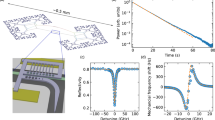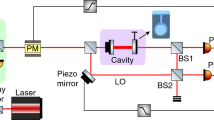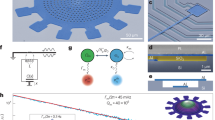Abstract
Quantum fluctuations of the electromagnetic vacuum produce measurable physical effects such as Casimir forces and the Lamb shift1. They also impose an observable limit—known as the quantum backaction limit—on the lowest temperatures that can be reached using conventional laser cooling techniques2,3. As laser cooling experiments continue to bring massive mechanical systems to unprecedentedly low temperatures4,5, this seemingly fundamental limit is increasingly important in the laboratory6. Fortunately, vacuum fluctuations are not immutable and can be ‘squeezed’, reducing amplitude fluctuations at the expense of phase fluctuations. Here we propose and experimentally demonstrate that squeezed light can be used to cool the motion of a macroscopic mechanical object below the quantum backaction limit. We first cool a microwave cavity optomechanical system using a coherent state of light to within 15 per cent of this limit. We then cool the system to more than two decibels below the quantum backaction limit using a squeezed microwave field generated by a Josephson parametric amplifier. From heterodyne spectroscopy of the mechanical sidebands, we measure a minimum thermal occupancy of 0.19 ± 0.01 phonons. With our technique, even low-frequency mechanical oscillators can in principle be cooled arbitrarily close to the motional ground state, enabling the exploration of quantum physics in larger, more massive systems.
This is a preview of subscription content, access via your institution
Access options
Access Nature and 54 other Nature Portfolio journals
Get Nature+, our best-value online-access subscription
$29.99 / 30 days
cancel any time
Subscribe to this journal
Receive 51 print issues and online access
$199.00 per year
only $3.90 per issue
Buy this article
- Purchase on Springer Link
- Instant access to full article PDF
Prices may be subject to local taxes which are calculated during checkout




Similar content being viewed by others
References
Milonni, P. W. The Quantum Vacuum: An Introduction to Quantum Electrodynamics (Academic Press, 1993)
Marquardt, F., Chen, J. P., Clerk, A. A. & Girvin, S. M. Quantum theory of cavity-assisted sideband cooling of mechanical motion. Phys. Rev. Lett. 99, 093902 (2007)
Wilson-Rae, I., Nooshi, N., Zwerger, W. & Kippenberg, T. J. Theory of ground state cooling of a mechanical oscillator using dynamical backaction. Phys. Rev. Lett. 99, 093901 (2007)
Teufel, J. D. et al. Sideband cooling of micromechanical motion to the quantum ground state. Nature 475, 359–363 (2011)
Chan, J. et al. Laser cooling of a nanomechanical oscillator into its quantum ground state. Nature 478, 89–92 (2011)
Peterson, R. et al. Laser cooling of a micromechanical membrane to the quantum backaction limit. Phys. Rev. Lett. 116, 063601 (2016)
Aspelmeyer, M., Kippenberg, T. J. & Marquardt, F. Cavity optomechanics. Rev. Mod. Phys. 86, 1391–1452 (2014)
O’Connell, A. D. et al. Quantum ground state and single-phonon control of a mechanical resonator. Nature 464, 697–703 (2010)
Riedinger, R. et al. Non-classical correlations between single photons and phonons from a mechanical oscillator. Nature 530, 313–316 (2016)
Wilson, D. J. et al. Measurement-based control of a mechanical oscillator at its thermal decoherence rate. Nature 524, 325–329 (2015)
Phillips, W. D. Nobel lecture: Laser cooling and trapping of neutral atoms. Rev. Mod. Phys. 70, 721–741 (1998)
Wineland, D. J. Nobel lecture: Superposition, entanglement, and raising Schrodinger’s cat. Rev. Mod. Phys. 85, 1103–1114 (2013)
Vanner, M. R. et al. Pulsed quantum optomechanics. Proc. Natl Acad. Sci. USA 108, 16182–16187 (2011)
Liu, Y.-C., Xiao, Y.-F., Luan, X. & Wong, C. W. Dynamic dissipative cooling of a mechanical resonator in strong coupling optomechanics. Phys. Rev. Lett. 110, 153606 (2013)
Elste, F., Girvin, S. M. & Clerk, A. A. Quantum noise interference and backaction cooling in cavity nanomechanics. Phys. Rev. Lett. 102, 207209 (2009)
Ojanen, T. & Børkje, K. Ground-state cooling of mechanical motion in the unresolved sideband regime by use of optomechanically induced transparency. Phys. Rev. A 90, 013824 (2014)
Huang, S. & Agarwal, G. S. Enhancement of cavity cooling of a micromechanical mirror using parametric interactions. Phys. Rev. A 79, 013821 (2009)
Lü, X.-Y. et al. Squeezed optomechanics with phase-matched amplification and dissipation. Phys. Rev. Lett. 114, 093602 (2015)
Cirac, J. I. & Zoller, P. Laser cooling of trapped ions in a squeezed vacuum. Phys. Rev. A 47, 2191–2195 (1993)
Graham, R., Walls, D. F. & Zhang, W. Laser cooling in a squeezed vacuum. Phys. Rev. A 44, 7777–7784 (1991)
Shevy, Y. Laser cooling of atoms in squeezed vacuum. Phys. Rev. Lett. 64, 2905–2908 (1990)
Loudon, R. & Knight, P. L. Squeezed light. J. Mod. Opt. 34, 709–759 (1987)
Caves, C. M. Quantum-mechanical noise in an interferometer. Phys. Rev. D 23, 1693–1708 (1981)
Clark, J. B., Lecocq, F., Simmonds, R. W., Aumentado, J. & Teufel, J. D. Observation of strong radiation pressure forces from squeezed light on a mechanical oscillator. Nat. Phys. 12, 683–687 (2016)
Paris, M. G. A., Illuminati, F., Serafini, A. & De Siena, S. Purity of Gaussian states: measurement schemes and time evolution in noisy channels. Phys. Rev. A 68, 012314 (2003)
Cicak, K. et al. Low-loss superconducting resonant circuits using vacuum-gap-based microwave components. Appl. Phys. Lett. 96, 093502 (2010)
Safavi-Naeini, A. H. et al. Laser noise in cavity-optomechanical cooling and thermometry. New J. Phys. 15, 035007 (2013)
Purdy, T. P. et al. Optomechanical Raman-ratio thermometry. Phys. Rev. A 92, 031802 (2015)
Underwood, M. et al. Measurement of the motional sidebands of a nanogram-scale oscillator in the quantum regime. Phys. Rev. A 92, 061801 (2015)
Vahlbruch, H., Mehmet, M., Danzmann, K. & Schnabel, R. Detection of 15 dB squeezed states of light and their application for the absolute calibration of photoelectric quantum efficiency. Phys. Rev. Lett. 117, 110801 (2016)
Harlow, J. Microwave Electromechanics: Measuring and Manipulating the Quantum State of a Macroscopic Mechanical Oscillator. PhD thesis, Univ. Colorado, Boulder (2013)
Fabre, C. et al. Quantum-noise reduction using a cavity with a movable mirror. Phys. Rev. A 49, 1337–1343 (1994)
Mancini, S. & Tombesi, P. Quantum noise reduction by radiation pressure. Phys. Rev. A 49, 4055–4065 (1994)
Brooks, D. W. C. et al. Non-classical light generated by quantum-noise-driven cavity optomechanics. Nature 488, 476–480 (2012)
Purdy, T. P., Yu, P.-L., Peterson, R. W., Kampel, N. S. & Regal, C. A. Strong optomechanical squeezing of light. Phys. Rev. X 3, 031012 (2013)
Safavi-Naeini, A. H. et al. Squeezed light from a silicon micromechanical resonator. Nature 500, 185–189 (2013)
Dobrindt, J. M., Wilson-Rae, I. & Kippenberg, T. J. Parametric normal-mode splitting in cavity optomechanics. Phys. Rev. Lett. 101, 263602 (2008)
Teufel, J. D. et al. Circuit cavity electromechanics in the strong-coupling regime. Nature 471, 204–208 (2011)
Verhagen, E., Delglise, S., Weis, S., Schliesser, A. & Kippenberg, T. J. Quantum-coherent coupling of a mechanical oscillator to an optical cavity mode. Nature 482, 63–67 (2012)
Acknowledgements
This work was financially supported by NIST and the DARPA QuASAR program. J.B.C. acknowledges the NIST National Research Council Postdoctoral Research Associateship Program for its financial support. Contribution of the US government, not subject to copyright.
Author information
Authors and Affiliations
Contributions
J.B.C. and J.D.T. conceived and designed the experiment. F.L. fabricated the optomechanical circuit and contributed technical input for the experimental set-up. J.B.C. performed the measurements and data analysis, and developed the theory with assistance from J.D.T. All authors contributed to writing the manuscript.
Corresponding author
Ethics declarations
Competing interests
The authors declare no competing financial interests.
Additional information
Reviewer Information Nature thanks P. Tombesi and the other anonymous reviewer(s) for their contribution to the peer review of this work.
Extended data figures and tables
Extended Data Figure 1 Cryogenic measurement set-up.
LPF, low-pass filter; JPA, Josephson parametric amplifier; OM, optomechanical; HEMT, high-electron-mobility transistor amplifier; μ-wave, microwave. The components shaded in grey signify broadband microwave attenuators. The rectangular components shaded red indicate directional couplers.
Extended Data Figure 2 Calculated power spectral density of the ponderomotive squeezing and antisqueezing that would be detected by an ideal homodyne receiver.
The solid lines indicate pondermotive squeezing and the dashed lines antisqueezing. SNL denotes the shot-noise limit (vacuum fluctuations). The indicated mechanical resonance frequency Ω includes optical springing effects. The colour of each curve denotes the resultant power spectral density produced by either of two coherent-state pump detunings satisfying (Δ/Δ0) ± 1 = constant. Here, Δ0 denotes the traditional optimal drive detuning when sideband cooling with coherent states (equation (31)). All curves assume a mechanical quality factor Qm = 5 × 105, a constant (and strong) optical damping rate Γopt = Γ+ − Γ− = 103Γ, a lossless optomechanical cavity and zero temperature. Additionally, a normalized cavity linewidth κ/Ω ≈ 2.85 has been assumed, which yields −10 dB of ponderomotive squeezing when Δ = Δ0 (see equation (30)).
Extended Data Figure 3 Calculated power spectral density (PSD) of the reflected drive field as would be detected by an ideal homodyne receiver.
The field quadrature being plotted is that which is maximally squeezed (ponderomotively). SNL denotes the shot-noise limit (vacuum fluctuations). All panels assume the same conditions as for Fig. 2, with the exception of a constant drive detuning (Δ = Δ0) and a constant drive cooperativity C = 4g2/(κΓ ) = 5,000. Each panel assumes a different level of injected squeezing, although the optimal squeezing phase θ = θ0 (equation (11)) is assumed throughout. The strength of the injected squeezing is parameterized by r, expressed in units of the critical squeezing parameter rc. The critical squeezing for this cavity is −5 dB.
Extended Data Figure 4 Modelling the impurity of the squeezing.
a, A pure squeezed state (with squeezing strength parameterized by rin) is subject to loss via a beamsplitter of transmittance ηin. Although the loss is to vacuum, the resulting squeezed state is impure and does not obey the minimum uncertainty relation:  . b, Amplitude variance
. b, Amplitude variance  of a pure −10 dB squeezed state subject to loss as the squeezing phase θ is rotated (see inset). c, The Gaussian state in the right-hand panel of a can be equivalently represented with nl and r. The impurity is captured by the uncertainty product
of a pure −10 dB squeezed state subject to loss as the squeezing phase θ is rotated (see inset). c, The Gaussian state in the right-hand panel of a can be equivalently represented with nl and r. The impurity is captured by the uncertainty product  , which is maintained in the presence of an ideal entropy-preserving squeezing operation (parameterized by r). The dashed circles denote the standard vacuum fluctuations for reference. d, e, Computed values of r (d) and nl (e) given various values of input squeezing rin and ηin (see equations (39) and (40)).
, which is maintained in the presence of an ideal entropy-preserving squeezing operation (parameterized by r). The dashed circles denote the standard vacuum fluctuations for reference. d, e, Computed values of r (d) and nl (e) given various values of input squeezing rin and ηin (see equations (39) and (40)).
Extended Data Figure 5 Numerically computed effective mechanical bath occupancy plotted against the normalized coupling rate g/κ for various pure squeezed states.
By numerically computing the full bath occupancy  , we account for the role of ‘strong coupling’ physics discussed elsewhere. Various squeezing parameters r were considered (expressed in units of the critical squeezing parameter rc in equation (5)). All curves assume drive detuning Δ = Δ0 (equation (31)) and squeezing phase θ = θ0 (equation (11)). The optomechanical system is assumed to be deep in the resolved sideband cooling limit (κ/Ω = 0.1). The grey dashed line shows the strong coupling limit to the squeezing-enhanced cooling, which scales as (g/Ω)2.
, we account for the role of ‘strong coupling’ physics discussed elsewhere. Various squeezing parameters r were considered (expressed in units of the critical squeezing parameter rc in equation (5)). All curves assume drive detuning Δ = Δ0 (equation (31)) and squeezing phase θ = θ0 (equation (11)). The optomechanical system is assumed to be deep in the resolved sideband cooling limit (κ/Ω = 0.1). The grey dashed line shows the strong coupling limit to the squeezing-enhanced cooling, which scales as (g/Ω)2.
Extended Data Figure 6 Comparison of the mechanical bath temperature with squeezed and unsqueenzed light in the presence of internal cavity loss.
The solid and dashed lines correspond to the mechanical bath temperature with squeezed ( ; equation (42)) and unsqueezed (
; equation (42)) and unsqueezed ( ; equation (2)) light, respectively. The bath occupancies are plotted as a function of the external coupling rate κext normalized by the internal loss rate of the cavity κ0. Each colour corresponds to a different value of κ0. All curves assume a drive detuning Δ0 (equation (31)) from cavity resonance and the corresponding optimal squeezing phase θ0 (equation (11)).
; equation (2)) light, respectively. The bath occupancies are plotted as a function of the external coupling rate κext normalized by the internal loss rate of the cavity κ0. Each colour corresponds to a different value of κ0. All curves assume a drive detuning Δ0 (equation (31)) from cavity resonance and the corresponding optimal squeezing phase θ0 (equation (11)).  and
and  approach the same limit (equation (44)) as κext/κ0 → 0, indicating that internal cavity loss limits the coldest temperatures that can be reached when sideband cooling with any Gaussian state. For
approach the same limit (equation (44)) as κext/κ0 → 0, indicating that internal cavity loss limits the coldest temperatures that can be reached when sideband cooling with any Gaussian state. For  ,
,  diverges (equation (46)) whereas
diverges (equation (46)) whereas  asymptotically approaches the ratio κ0/(4Ω) (equation (45)).
asymptotically approaches the ratio κ0/(4Ω) (equation (45)).
Rights and permissions
About this article
Cite this article
Clark, J., Lecocq, F., Simmonds, R. et al. Sideband cooling beyond the quantum backaction limit with squeezed light. Nature 541, 191–195 (2017). https://doi.org/10.1038/nature20604
Received:
Accepted:
Published:
Issue Date:
DOI: https://doi.org/10.1038/nature20604
This article is cited by
-
Enhancement of magnon–photon–phonon entanglement in a cavity magnomechanics with coherent feedback loop
Scientific Reports (2023)
-
Active-feedback quantum control of an integrated low-frequency mechanical resonator
Nature Communications (2023)
-
Broadband squeezed microwaves and amplification with a Josephson travelling-wave parametric amplifier
Nature Physics (2023)
-
Entangled light enhances force sensing
Nature Photonics (2023)
-
Optimal squeezed cooling of a mechanical oscillator using measurement-based vector feedback
Science China Physics, Mechanics & Astronomy (2023)
Comments
By submitting a comment you agree to abide by our Terms and Community Guidelines. If you find something abusive or that does not comply with our terms or guidelines please flag it as inappropriate.



